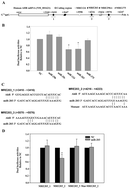AhR is negatively regulated by miR-203 in response to TCDD or BaP treatment†
Abstract
The aryl hydrocarbon receptor (AhR) is an important nuclear receptor and mediates the biological consequences in response to environmental stimuli. However, the mechanism of AhR regulation in this process is still unclear. In this study, we attempt to identify which microRNAs (miRNAs) specifically modify the expression of AhR in A549 and HepG2 cells. miR-203 was predicted to target AhR by bioinformatic analysis. We performed a luciferase reporter assay and found miR-203 specifically binding to the mRNA 3′-UTR region of AhR, leading to the suppression of the expression of AhR at both the mRNA and protein levels. When exposed to TCDD or BaP, the expression of miR-203 could be induced and resulted in a reduction of AhR expression. The ectopic expression of miR-203 in A549 and HepG2 cells attenuated the activation of AhR induced by TCDD and subsequently suppressed its downstream regulated genes including cytochrome P450 1A1, 1A2 (CYP1A1, CYP1A2), and NADPH dehydrogenase 1 (NQO1). Moreover, overexpression of miR-203 affects the inducible enzyme activity of CYP1A1 by TCDD induction and the cytotoxicity induced by BaP. Taken together, we identify a novel miRNA that negatively regulates the expression of AhR, demonstrating that epigenetic modifications play a critical role in the metabolic activation of environmental chemicals.


 Please wait while we load your content...
Please wait while we load your content...